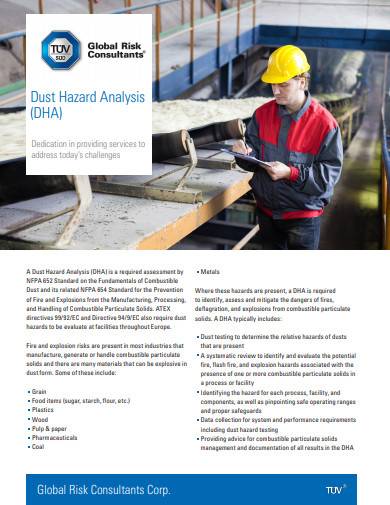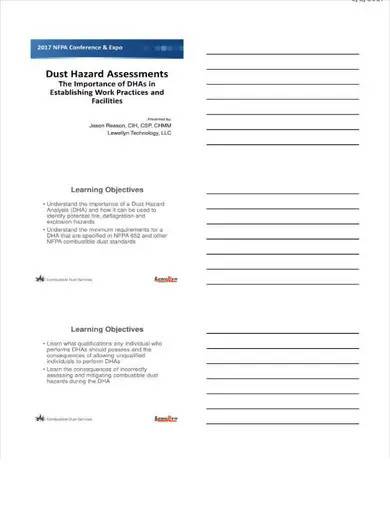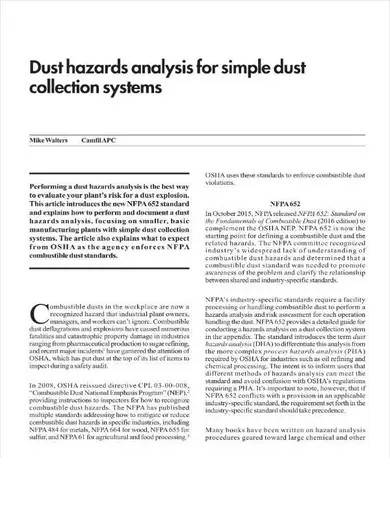Dust explosions can occur in any industrial application that involves the handling of bulk powders. That’s why many companies should need to properly implement dust explosion prevention and mitigation for a process safety approach to be truly effective. If your business or company uses various materials that contain different types of powders, you should be aware that you need an analysis report regarding dust hazard. In this article, we provide you some useful steps and a diverse selection of analysis templates that you can freely download and use for your business. Keep on reading!
FREE 5+ Dust Hazard Analysis Samples
1. Dust Hazard Analysis Template
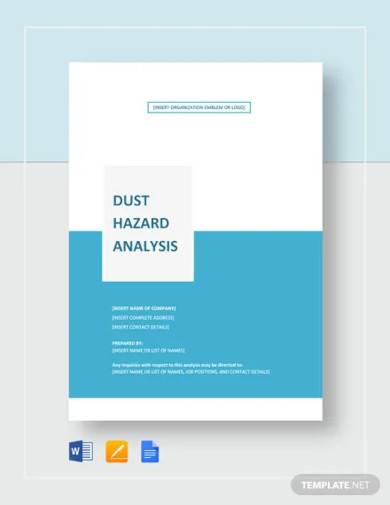
2. Hazard Analysis Template
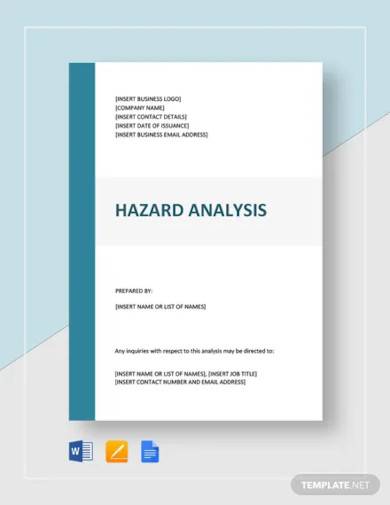
3. Professional Dust Hazard Analysis
4. Dust Hazard Assessment Template
5. Formal Dust Hazard Analysis
6. Dust Explosion Hazard Assessment
What is a Dust Hazard Analysis?
The book “Methods in Chemical Process Safety” explains that any solid material that can burn in air will create a potential dust explosion. There is a great increase of the combustion rate of a given mass of combustible solid while increasing sub-division occurs. When the small particles are suspended in a sufficiently large volume of air to give each particle enough space for its unrestricted burning, the combustion rate will be very quick, and the energy required for ignition is very little.
Thus, a dust hazard analysis is a significant instrument used to enhance plant safety by determining the specific combustible dust hazards related to a process. You will need to analyze your business environment and your processes. In this way, you can identify possible dangers and establish a plan to diminish those risks.
How to Create a Dust Hazard Analysis Report
Writing a dust hazard analysis for your business or company is very important to prevent possible occurrence of explosion that can lead to many risks. If you’re having a hard time preparing your analysis, we suggest that you use our templates above that you can use easily. Here are the steps that you need to follow:
1. Obtain essential documents and files
You should start gathering any available useful visual illustrations and documents that identify the equipment, process, operating parameters, or existing hazards such as general arrangement drawings, equipment manufacturer drawings, data sheets, and manuals, process flow diagrams, piping and instrumentation diagrams, building plans, electrical hazard classification drawings, and many more. Also, conduct an interview to plant operations staff to acquire necessary process data that is not included in the files you collected.
2. Verify the collected data
Take a field survey in your business or company to carefully search and observe the equipment, buildings, and many others. If the facility is older as well as the existing documents and files, it is certain that there have been changes and other modifications that are left undocumented.
3. Establish a team
Select and bring professionals such as plan engineers, environmental health and safety personnel, and plant management key individuals to form and establish a team for conducting a dust hazard analysis report. Include maintenance and operations personnel who have some proper skills, expertise, and experience in handling possible combustible dust hazards.
4. Determine hazards and examine compliance
Is there enough dust to generate a combustible atmosphere? Might there be any ignitions sources? Use these questions while you and your team should systematically analyze and contemplate carefully about your process and facility to determine the possible hazards. So, consider every point in the process, determine hazards, as well as the measures necessary to lessen the risks.
5. Classify the hazards and record results
Classify the potential hazards and rank them according to the expected probability that the event could occur and its predictable austerity. After this, you should thoroughly record the results for your report. It should be clear and structured as the report serves as a reference for the management.
FAQ
Based on this article, OSHA cannot demand a dust hazard analysis since they don’t have an official standard requiring a dust hazard analysis. But, there are OSHA standards for Process Hazard Analysis, and any dust-producing process should include combustible dust issues in the analysis.Does OSHA require a dust hazard analysis?
The five elements of a combustible dust explosion are oxygen, heat, fuel, dispersion, and confinement. If one element is missing, an explosion is impossible to happen.What are the 5 elements of a combustible dust explosion?
Some examples of combustible dust are wood, rubber, pesticides, pharmaceuticals, chemical dusts like coal and sulphur, metals like aluminum and bronze, and agricultural products. What are examples of combustible dust?
An article explained that the employer should provide a workplace that is free from serious recognized hazards and comply with rules, regulations, and standards issued under the OSH Act. He or she needs to inspect workplace conditions, ensuring they conform to applicable OSHA standards. Employees need to have and utilize safe tools and equipment and maintain this equipment properly.What responsibilities does an employer have to ensure a safe and healthy work environment without those hazards for employees?
Therefore, dust clouds will be easier to create ignition and they will burn more violently the smaller the dust particles are, down to some limiting particle size according to the type of dust material. If an explosive combustion of a dust suddenly occurred inside a process equipment or work rooms, the pressure may cause an explosion that may immensely destroy several equipment and buildings. So, if you’re a safety manager of a certain business, you need to have an analysis template today and create your dust hazard analysis report conveniently.
Related Posts
FREE 10+ Soar Analysis Samples in PDF
FREE 10+ Rhetorical Analysis Samples in PDF
FREE 10+ Analysis of Alternatives Samples in PDF
FREE 10+ Failure Mode and Effects Analysis Samples in PDF
FREE 10+ Make or Buy Analysis Samples in PDF
FREE 10+ Fishbone Root Cause Analysis Samples in PDF
FREE 11+ Cost Volume Profit Analysis Samples & Templates in PDF | MS Word
FREE 6+ Corporate Portfolio Analysis Samples in PDF
FREE 10+ Fault Tree Analysis Samples in PDF
FREE 10+ Comp Analysis Samples in PDF
FREE 10+ Fishbone Analysis Samples in PDF
FREE 10+ Individual Swot Analysis Samples in PDF
FREE 10+ 5 Year Analysis Samples in PDF
FREE 10+ Benefit Costs Analysis Samples in PDF
FREE 10+ Job Hazard Analysis Samples in PDF

